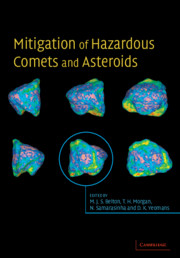Book contents
- Frontmatter
- Contents
- List of contributors
- Preface
- Acknowledgments
- Glossary
- 1 Recent progress in interpreting the nature of the near-Earth object population
- 2 Earth impactors: orbital characteristics and warning times
- 3 The role of radar in predicting and preventing asteroid and comet collisions with Earth
- 4 Interior structures for asteroids and cometary nuclei
- 5 What we know and don't know about surfaces of potentially hazardous small bodies
- 6 About deflecting asteroids and comets
- 7 Scientific requirements for understanding the near-Earth asteroid population
- 8 Physical properties of comets and asteroids inferred from fireball observations
- 9 Mitigation technologies and their requirements
- 10 Peering inside near-Earth objects with radio tomography
- 11 Seismological investigation of asteroid and comet interiors
- 12 Lander and penetrator science for near-Earth object mitigation studies
- 13 Optimal interception and deflection of Earth-approaching asteroids using low-thrust electric propulsion
- 14 Close proximity operations at small bodies: orbiting, hovering, and hopping
- 15 Mission operations in low-gravity regolith and dust
- 16 Impacts and the public: communicating the nature of the impact hazard
- 17 Towards a national program to remove the threat of hazardous NEOs
- Index
16 - Impacts and the public: communicating the nature of the impact hazard
Published online by Cambridge University Press: 12 October 2009
- Frontmatter
- Contents
- List of contributors
- Preface
- Acknowledgments
- Glossary
- 1 Recent progress in interpreting the nature of the near-Earth object population
- 2 Earth impactors: orbital characteristics and warning times
- 3 The role of radar in predicting and preventing asteroid and comet collisions with Earth
- 4 Interior structures for asteroids and cometary nuclei
- 5 What we know and don't know about surfaces of potentially hazardous small bodies
- 6 About deflecting asteroids and comets
- 7 Scientific requirements for understanding the near-Earth asteroid population
- 8 Physical properties of comets and asteroids inferred from fireball observations
- 9 Mitigation technologies and their requirements
- 10 Peering inside near-Earth objects with radio tomography
- 11 Seismological investigation of asteroid and comet interiors
- 12 Lander and penetrator science for near-Earth object mitigation studies
- 13 Optimal interception and deflection of Earth-approaching asteroids using low-thrust electric propulsion
- 14 Close proximity operations at small bodies: orbiting, hovering, and hopping
- 15 Mission operations in low-gravity regolith and dust
- 16 Impacts and the public: communicating the nature of the impact hazard
- 17 Towards a national program to remove the threat of hazardous NEOs
- Index
Summary
Introduction
In the twenty-first century, we must consider the asteroid and comet impact hazard in a context in which citizens of many nations are apprehensive about hazards associated with foods, disease, accidents, natural disasters, terrorism, and war. The ways we respond psychologically to such threats to our lives and well-being, and the degrees to which we expect our societal institutions (both governmental and private) to respond, are not directly proportional to actuarial estimates of the causes of human mortality, nor to forecasts of likely economic consequences. Our concerns about particular hazards are often heavily influenced by other factors, and they vary from year to year. Citizens of different nations demonstrate different degrees of concern about risks in the modern world (for example, reactions to eating genetically modified food or living near a nuclear power plant). Yet one would hope that public officials would base decisions at least in part on the best information available about the risks and costs, and scientists have a responsibility to assist them to reach defensible conclusions.
Objective estimates of the potential damage due to asteroid impacts (consequences multiplied by risk) are within the range of other risks that governments often take very seriously (Morrison et al. 1994). Moreover, public interest is high, fueled by increasing discovery rates and the continuing interests of the international news media. In this chapter we consider the past, present, and future of interactions by scientists with the public and media on the subject of the impact hazard.
- Type
- Chapter
- Information
- Mitigation of Hazardous Comets and Asteroids , pp. 353 - 390Publisher: Cambridge University PressPrint publication year: 2004
- 16
- Cited by

